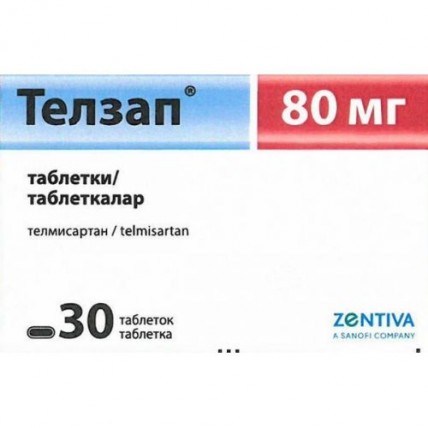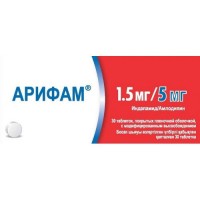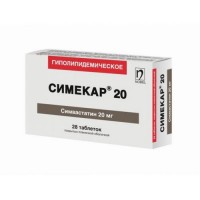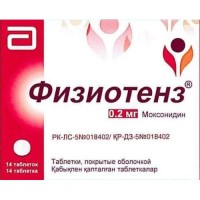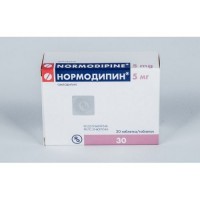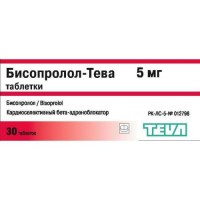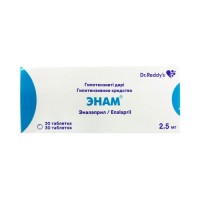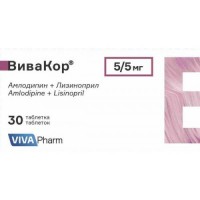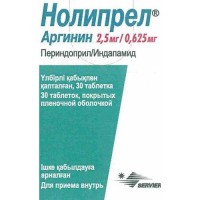Telzap 80 mg (30 tablets)
- $18.10
The instruction for medical use of Telzap Torgovoye medicine a name Telzap Mezhdunarodnoye the unlicensed name Telmisartan Lekarstvennaya a form of the Tablet of 40 mg or 80 mg Structure 1 tablet contains active agents - telmisartan – 40 or 80 mg respectively, excipients: Megluminum, sorbitol, sodium hydroxide, povidone 25, magnesium stearate the Description of the Tablet belovato - yellowish color, oblong, with a biconvex surface and risky from two parties (for a dosage of 40 mg), with marking 80 on one party (for a dosage of 80 mg) Pharmacotherapeutic group Drugs for treatment of a cardiovascular ststema. The drugs influencing a system renin-angiotensin. Angiotensin II antagonists. Telmisartan the ATX C09CA07 Code the Pharmacological Pharmacokinetics Absorption properties of a telmisartan occurs quickly. The average absolute bioavailability for a telmisartan is about 50%. If to accept telmisartan together with food, reduction of the area under time concentration curve in plasma (AUC0-∞) the telmisartana changes from 6% (a dose in 40 mg) approximately up to 19% (a dose in 160 mg). In 3 hours after reception of concentration in plasma do not change, irrespective of reception of a telmisartan together with food or on an empty stomach. Small decrease in AUC does not involve easing of therapeutic effect. Between doses and levels in plasma there is no linear communication. Telmisartan contacts plasma proteins (& gt, 99.5%), mainly, albumine and a glycoprotein of acid alfa-1. The average volume of distribution in steady state (Vdss) is about 500 l. Telmisartan is characterized by pharmacokinetics of biexponentsialny disintegration with final elimination half-life & gt, 20 hours. The maximum concentration in plasma (Cmax) and, in smaller volume, the area under time concentration curve in plasma (AUC) increase in inverse proportion to a dose. The proof of clinically significant cumulation of the telmisartan accepted in the recommended dose no. Concentration in plasma were higher at women, than at men that did not affect considerably efficiency of drug. After peroral (and intravenous) reception telmisartan it is almost entirely brought out of an organism together with a chair, mainly, in not changed structure. Cumulative removal together with urine makes also lt, 1% of a dose. The general clearance of plasma (Clt) - high (approximately, 1.000 ml/min.) in comparison with a hepatic blood-groove (about 1.500 ml/min.). Influence depending on a sex of the patient: In concentration in plasma distinctions depending on a floor were observed. Cmax and AUC were, approximately in 3 and 2 times is higher, respectively, at women in comparison with men. Patients of advanced age: The pharmacokinetics of a telmisartan does not depend on age of patients. Patients with the broken renal function: At patients with small, average and heavy disturbance of renal function the doubling of concentration in plasma was observed. Nevertheless, at the patients with a renal failure undergoing dialysis lower concentration in plasma were observed. Telmisartan strongly contacts plasma proteins at patients with a renal failure, and cannot be removed by means of dialysis. Elimination half-life of drug from an organism does not change at patients with disturbance by renal function. Patients from the liver broken by function: Pharmacokinetic researches of patients from the liver broken by function showed increase in absolute bioavailability almost by 100%. Elimination half-life of drug from an organism does not change at patients from the liver broken by function. Pharmacodynamics action Mechanisms: Telmisartan is a peroral effective and specific antagonist of a receptor of angiotensin II (AT1 type). Telmisartan substitutes angiotensin II with very high degree of nearness of affinity in places of binding in a subtype of a receptor of AT1 which is responsible for the known effects of angiotensin II. Telmisartan does not show partial activity of agonist in AT1 receptor. Telmisartan selectively ties AT1 receptor. Binding lasts long time. Telmisartan does not show similarity to other receptors, including AT2 and other less characteristic receptors of AT. The functional role of these receptors is unknown, as well as action of their probable increased stimulation by angiotensin II which level increases telmisartany. Aldosteronum level in plasma decreases at reception of a telmisartan. Telmisartan does not suppress renin in human plasma and does not block ion channels. Telmisartan does not suppress the enzyme transforming angiotensin (kininaza of II), enzyme which also carries out bradykinin disintegration. Therefore, it does not cause side effects of bradykinin. At men the dose of a telmisartan in 80 mg almost completely reduces the increased arterial blood pressure caused by effect of angiotensin II. The effect of drug remains during more, than 24 hours, and also are fixed after 48 hours. Treatment of essential hypertensia: After reception of the first dose of a telmisartan, hypotensive action gradually becomes obvious within 3 hours. The maximum lowering of arterial pressure is reached in 4-8 weeks after an initiation of treatment, and supported throughout long-term therapy. Hypotensive action steadily remains over 24 hours after reception of a dose, and includes the last 4 hours before reception of the following dose as show out-patient measurements of arterial blood pressure. It is confirmed by increase in a ratio of coefficient of peak to residual effect which steadily remains at the level over 80% after reception of doses in 40 and 80 mg of a telmisartan in placebo controlled clinical trials. Here the obvious interrelation between a dose and time before restoration of basic data SABP (systolic arterial blood pressure) is visible. In this regard the data concerning DABP (diastolic arterial blood pressure) are contradictory. At patients with hypertensia telmisartan reduces systolic and diastolic arterial blood pressure, without affecting pulse rate. The hypotensive efficiency of a telmisartan is comparable to the active agents representing other classes of antihypertensive drugs (shown in the clinical trials comparing telmisartan with amlodipiny, atenolol, enalapril, a hydrochlorothiazide and lisinopril). After the sharp termination of reception of a telmisartan the arterial blood pressure gradually returns to values which were prior to treatment, for several days without the profound withdrawal. Dry cough was observed much less often at the patients accepting telmisartan than at the patients accepting APF inhibitors in clinical trials which compared two antihypertensive drugs. Prevention of cardiovascular incidence and mortality At patients age of 55 years or is more senior than high risk at which in the anamnesis: coronary heart disease, a stroke, passing disturbances of cerebral circulation (TIA), a disease of the peripheral vessels or diabetes of the 2nd type which are followed by injury of target organs (a retinopathy, a hypertrophy of LZh, macro - or a microalbuminuria), use of a telmisartan allows to reduce the frequency of myocardial infarctions, strokes, hospitalization and to reduce cardiovascular diseases mortality. At the same time, the frequency of cough and Quincke's disease were less often observed at patients who accepted telmisartan, than at the patients accepting IAPF whereas, hypotension to a bowl was noticed at the patients accepting telmisartan. Indications Treatment of arterial hypertension at adults Prevention of cardiovascular diseases at patients: - with the profound atherosclerotic cardiovascular diseases (in the anamnesis: a coronary artery disease, a stroke, disturbance of cerebral circulation or a disease peripheral arteries) or - with diabetes of the II type with the registered injury of target organs the Route of administration and doses Treatment of arterial hypertension: Usually effective dose makes 40 mg once a day. Some patients can be helped by a daily dose in 20 mg. Reception of a dose in 20 mg can be received, having divided a tablet in 40 mg along the dividing line. If target arterial blood pressure is not reached, a dose of a telmisartan it is possible to increase a maximum to 80 mg of times a day. As an alternative, telmisartan it is possible to accept together with diuretics of thiazide type as a hydrochlorothiazide which have the additional reducing effect on arterial blood pressure together with telmisartany. If you want to increase a dose, it is necessary to remember that the maximum antihypertensive effect is reached in four-eight weeks after the beginning of administration of drug. Prevention of cardiovascular diseases the Recommended dose makes 80 mg once a day. At the beginning of reception of a telmisartan for prevention of cardiovascular diseases the fixed monitoring of arterial blood pressure is recommended. Renal failure: for patients with slight or moderate diseases of kidneys it is not required to adjust a dose. Concerning patients with serious diseases of kidneys or with a hemodialysis the experience of administration of drug is limited. For these patients the lower initial dose in 20 mg the Liver failure At patients with a slight or moderate hepatic unsufficiency is recommended the dose should not exceed 40 mg once a day. Patients of advanced age Correction of a dose is not required. Side effects Infrequently - an upper respiratory tract infection, including pharyngitis and sinusitis, short wind - an infection of urinary ways, including cystitis, a renal failure, including an acute renal failure - anemia, a hyperpotassemia, the increased creatinine level in blood - a depression, insomnia, dizziness, a syncope, a stethalgia, an asthenia (weakness) - bradycardia, hypotension, orthostatic hypotension - an abdominal cavity pain, diarrhea, dyspepsia, a meteorism, vomiting - a hyperhidrosis, an itching, rash, myalgia, dorsodynias (e.g., a sciatica), muscular spasms Seldom - thrombocytopenia, the increased level of uric acid in blood, the increased level of liver enzymes, the increased creatine phosphokinase level in blood, decrease in level of hemoglobin - tachycardia - sensation of discomfort in a stomach, the abnormal liver function, dryness in a mouth - an erythema, a Quincke's disease, an enanthesis, a toxic enanthesis, eczema - an arthralgia, extremity pains - alarm - grippopodobny symptoms - visual disturbances Very seldom with an unknown frequency - sepsis, including lethal iskhod1 - an eosinophilia - an urtikariya - sinew pains (the symptoms similar to a tendinitis) 1B the research PRoFESSl, at reception of a telmisartan was observed increase in frequency of development of sepsis in comparison with placebo. This event could have accidental character or could be caused by the unknown the Contraindication mechanism now - hypersensitivity to a telmisartan or to any of components - pregnancy and the period of a lactation - disturbance of passability of bile-excreting channels - an abnormal liver function - hereditary intolerance of fructose - children's and teenage age up to 18 years. Medicinal interactions Medicines or a therapeutic class of medicines which can cause a hyperpotassemia: the salt substitutes containing potassium, kaliysberegayushchy diuretics, ACE inhibitors, antagonists of receptors of angiotensin II, non-steroidal anti-inflammatory drugs (including selection TsOG-2 inhibitors), heparin, immunosuppressors (cyclosporine or takrolimus), Trimethoprimum. Emergence of a giperkaliyemiya depends on contributing factors of risk. Kaliysberegayushchy diuretics or additives with potassium: Angiotensin II the antagonist reduces loss to potassium caused by effect of diuretic. Kaliysberegayushchy diuretics: spirinolakton, eplerenon, Triamterenum or amiloride, potassium additives or kaliysoderzhashchy solezamenitel can cause significant increase in level of potassium in serum. If, because of the established hypopotassemia, the concomitant use of drugs is shown, they need to be taken with caution and at frequent monitoring of level of potassium in serum. Lithium: Reversible growth of concentration of lithium in serum and toxicity was noted during a concomitant use of lithium with APF inhibitors, and, in rare instances, with antagonists of angiotensin II. If the combined administration of drugs is necessary, it is recommended to carry out frequent monitoring of level of lithium in serum. Non-steroidal anti-inflammatory drugs (NPVS): NPVS (acetylsalicylic acid in anti-inflammatory doses, TsOG-2 inhibitors and non-selective NPVP) can reduce antihypertensive action of antagonists of angiotensin II. At some patients with the broken renal function (patients with dehydration or patients of advanced age with the broken renal function) the concomitant use of antagonists of angiotensin II and active agents which suppress cyclooxygenase can lead to further deterioration in renal function, including a probable acute renal failure which usually has reversible character. Therefore, the combined drugs need to be taken with caution, especially to people of advanced age. During treatment the patients have to receive adequate amount of liquid and it is necessary to carry out monitoring of renal function along with the beginning of therapy. Diuretics (thiazide or loopback diurektik): Preliminary treatment by high doses of diuretics can cause dehydration of an organism and risk of hypotension at the beginning of reception of a telmisartan. Other active agents with antihypertensive effect the Hypotensive action of a telmisartan, can amplify at a concomitant use of other antihypertensive medicines. Based on pharmacological properties, it is possible to assume that the following medicines can strengthen hypotensive effect of all antihypertensive drugs, including telmisartan: Baclofenum, amifostin. Besides, orthostatic hypotension can amplify at consumption of alcoholic drinks, at reception of barbiturates, drugs or antidepressants. Corticosteroids (systemic action): the concomitant use of corticosteroids and a telmisartan reduces the main effect of the last. Patients cannot accept the special instructions Liver Disease Telmisartan with a cholestasia, obstruction of bile or an acute liver failure as telmisartan it is mainly removed together with bile. At these patients the reduced clearance of a liver for a telmisartan will be observed. Patients with weak or moderate diseases of a liver can accept telmisartan with extra care. Renovascular arterial hypertension: There is an increased risk of high hypertensia and renal failure if patients with a bilateral renal arterial stenosis or a stenosis of an artery of the only functioning kidney take medicine which influences the system of renin-angiotensin-Aldosteronum. Renal disease and transplantation of a kidney: If patients with impaired renal function accept telmisartan, periodic observation of levels of potassium and creatinine in serum is recommended. Information on reception of a telmisartan by patients with recent renal transplantation is absent. Intravascular hypovolemia: Symptomatic hypotension, especially after reception of the first dose, can be observed at the dehydrated patients, as a result of intensive intake of diuretic drugs, a diet with restriction of salt, diarrhea or vomiting. These symptoms have to be eliminated before reception of a telmisartan. Before reception of a telmisartan it is necessary to restore the level of liquid and/or sodium in an organism to normal value. Double blockade of a system renin-angiotensin-Aldosteronum: As a result of suppression of a system of renin-angiotensin-Aldosteronum, hypotension, a syncope, the hyperpotassemia and changes in renal function (including an acute renal failure) were noted at susceptible patients, especially in combination with drugs which influence this system. Double blockade of a system renin-angiotensin-Aldosteronum (e.g., by addition of APF inhibitor to the antagonist of a receptor of angiotensin II) is not recommended to patients, already receiving hypotensive drugs, and has to be limited in some cases under fixed observation of renal function. Other conditions with stimulation of a system renin-angiotensin-Aldosteronum: At patients, with serious stagnant heart failure or with a disease of kidneys, including a renal artery stenosis, treatment
to an aratama pra, influencing a system renin-angiotensin-Aldosteronum as telmisartan, is followed by acute hypotension, the increased nitrogen content in an organism, an oliguria or, in rare instances, an acute renal failure. Primary aldosteronism: To patients with primary aldosteronism the antihypertensive drugs operating by suppression system renin-angiotenzinnoy are not effective. Therefore, reception of a telmisartan is not recommended. Stenosis of an aorta and mitral valve, obturatsionny hypertrophic cardiomyopathy: As well as at intake of other vasodilators, to the patients having a stenosis of aortal or mitral valves or an obturatsionny hypertrophic cardiomyopathy, it is necessary to observe extra care. Hyperpotassemia: Administration of drugs which influence the system of renin-angiotensin-Aldosteronum can cause a hyperpotassemia. For people of advanced age, patients with a renal failure, the diabetics, patients who are at the same time taking other medicines which can increase potassium level in an organism, and/or for patients with intercurrent diseases a hyperpotassemia can become deadly. Sorbite: The recommended daily dose of Телзап® 80 mg contains 324.4 mg of sorbite in tablets. Patients with hereditary intolerance of fructose should not take this drug. Other: From observations of effect of APF inhibitors, telmisartan and other antagonists of angiotensin is less effective in a lowering of arterial pressure at people of black race, than at representatives of other races probably because of the low level of renin at the representatives of black race suffering from supertension. As in a case with other hypotensive drugs, the considerable lowering of arterial pressure at the patients having an ischemic cardiopathy or an ischemic cardiovascular disease can lead to a myocardial infarction or to a stroke. Pregnancy and a lactation Safety and efficiency drug during pregnancy and feeding by a breast are not established. In this regard Telzap® is not recommended to be accepted, and it is preferable to pass to other alternative treatment with better the established safety profiles during feeding by a breast, especially concerning newborn or premature children. Features of influence of medicine on ability to run the vehicle or potentially dangerous mechanisms of the Research concerning influence of drug on ability of driving and work with the equipment were not carried out. Nevertheless, when driving the car or work with the equipment it should be noted that the drug Telzap® can cause dizziness and drowsiness. Overdose Symptoms: hypotension and tachycardia can be the most probable manifestations of overdose of a telmisartan, bradycardia, dizziness, increase in creatinine in serum, and an acute renal failure were also noted. Treatment: The patient has to be under strict observation, treatment has to be symptomatic and supporting. Treatment depends on time of reception and on the degree of manifestation of symptoms. Potential measures include calling of vomiting and/or gastric lavage, use of activated carbon. Control of electrolytes and creatinine of serum is shown. In case of hypotension, the patient needs to be laid on a back and to often give him salty drink. The hemodialysis is inefficient. The form of release and packing On 10 tablets place in blister strip packaging from a film of polyvinylchloride and aluminum foil. On 3 or 9 blister strip packagings together with the instruction for medical use in the state and Russian languages put in a pack from cardboard. To Store storage conditions at a temperature not above 30ºС in the place protected from moisture, in original packing. To store out of children's reach! 2 years not to apply a period of storage after an expiration date. Prescription status According to the prescription the Producer / Owner of the registration certificate Zentiva to. page, Prague, the Czech Republic the Address of the organization accepting in the territory of the Republic of Kazakhstan claims from consumers on quality of products (goods) of Sanofi-aventis Kazakhstan LLP 050013 Almaty, Furmanov St. of 187 B phone number: 8-727-244-50-96 fax: 8-727-258-25-96 e-mail: The Name, the address and a contact information (phone, the fax, e-mail) of the organization in the territory of the Republic of Kazakhstan responsible for post-registration observation of safety of medicine of Sanofi-aventis Kazakhstan LLP Republic of Kazakhstan, 050013, Almaty, Furmanov St. of 187 B
to Develop quality.info@sanofi.com
to an aratama pra, influencing a system renin-angiotensin-Aldosteronum as telmisartan, is followed by acute hypotension, the increased nitrogen content in an organism, an oliguria or, in rare instances, an acute renal failure. Primary aldosteronism: To patients with primary aldosteronism the antihypertensive drugs operating by suppression system renin-angiotenzinnoy are not effective. Therefore, reception of a telmisartan is not recommended. Stenosis of an aorta and mitral valve, obturatsionny hypertrophic cardiomyopathy: As well as at intake of other vasodilators, to the patients having a stenosis of aortal or mitral valves or an obturatsionny hypertrophic cardiomyopathy, it is necessary to observe extra care. Hyperpotassemia: Administration of drugs which influence the system of renin-angiotensin-Aldosteronum can cause a hyperpotassemia. For people of advanced age, patients with a renal failure, the diabetics, patients who are at the same time taking other medicines which can increase potassium level in an organism, and/or for patients with intercurrent diseases a hyperpotassemia can become deadly. Sorbite: The recommended daily dose of Телзап® 80 mg contains 324.4 mg of sorbite in tablets. Patients with hereditary intolerance of fructose should not take this drug. Other: From observations of effect of APF inhibitors, telmisartan and other antagonists of angiotensin is less effective in a lowering of arterial pressure at people of black race, than at representatives of other races probably because of the low level of renin at the representatives of black race suffering from supertension. As in a case with other hypotensive drugs, the considerable lowering of arterial pressure at the patients having an ischemic cardiopathy or an ischemic cardiovascular disease can lead to a myocardial infarction or to a stroke. Pregnancy and a lactation Safety and efficiency drug during pregnancy and feeding by a breast are not established. In this regard Telzap® is not recommended to be accepted, and it is preferable to pass to other alternative treatment with better the established safety profiles during feeding by a breast, especially concerning newborn or premature children. Features of influence of medicine on ability to run the vehicle or potentially dangerous mechanisms of the Research concerning influence of drug on ability of driving and work with the equipment were not carried out. Nevertheless, when driving the car or work with the equipment it should be noted that the drug Telzap® can cause dizziness and drowsiness. Overdose Symptoms: hypotension and tachycardia can be the most probable manifestations of overdose of a telmisartan, bradycardia, dizziness, increase in creatinine in serum, and an acute renal failure were also noted. Treatment: The patient has to be under strict observation, treatment has to be symptomatic and supporting. Treatment depends on time of reception and on the degree of manifestation of symptoms. Potential measures include calling of vomiting and/or gastric lavage, use of activated carbon. Control of electrolytes and creatinine of serum is shown. In case of hypotension, the patient needs to be laid on a back and to often give him salty drink. The hemodialysis is inefficient. The form of release and packing On 10 tablets place in blister strip packaging from a film of polyvinylchloride and aluminum foil. On 3 or 9 blister strip packagings together with the instruction for medical use in the state and Russian languages put in a pack from cardboard. To Store storage conditions at a temperature not above 30ºС in the place protected from moisture, in original packing. To store out of children's reach! 2 years not to apply a period of storage after an expiration date. Prescription status According to the prescription the Producer / Owner of the registration certificate Zentiva to. page, Prague, the Czech Republic the Address of the organization accepting in the territory of the Republic of Kazakhstan claims from consumers on quality of products (goods) of Sanofi-aventis Kazakhstan LLP 050013 Almaty, Furmanov St. of 187 B phone number: 8-727-244-50-96 fax: 8-727-258-25-96 e-mail: The Name, the address and a contact information (phone, the fax, e-mail) of the organization in the territory of the Republic of Kazakhstan responsible for post-registration observation of safety of medicine of Sanofi-aventis Kazakhstan LLP Republic of Kazakhstan, 050013, Almaty, Furmanov St. of 187 B
to Develop quality.info@sanofi.com
